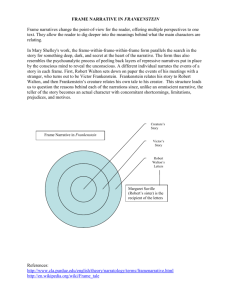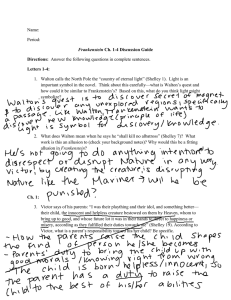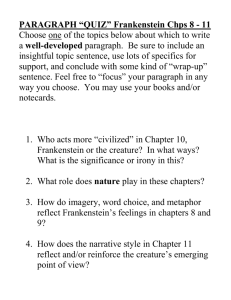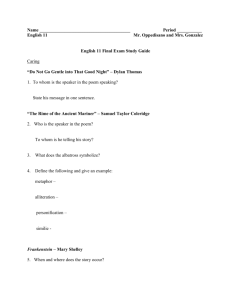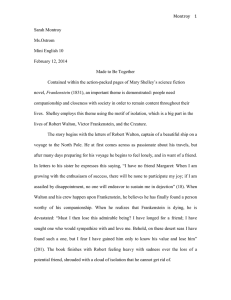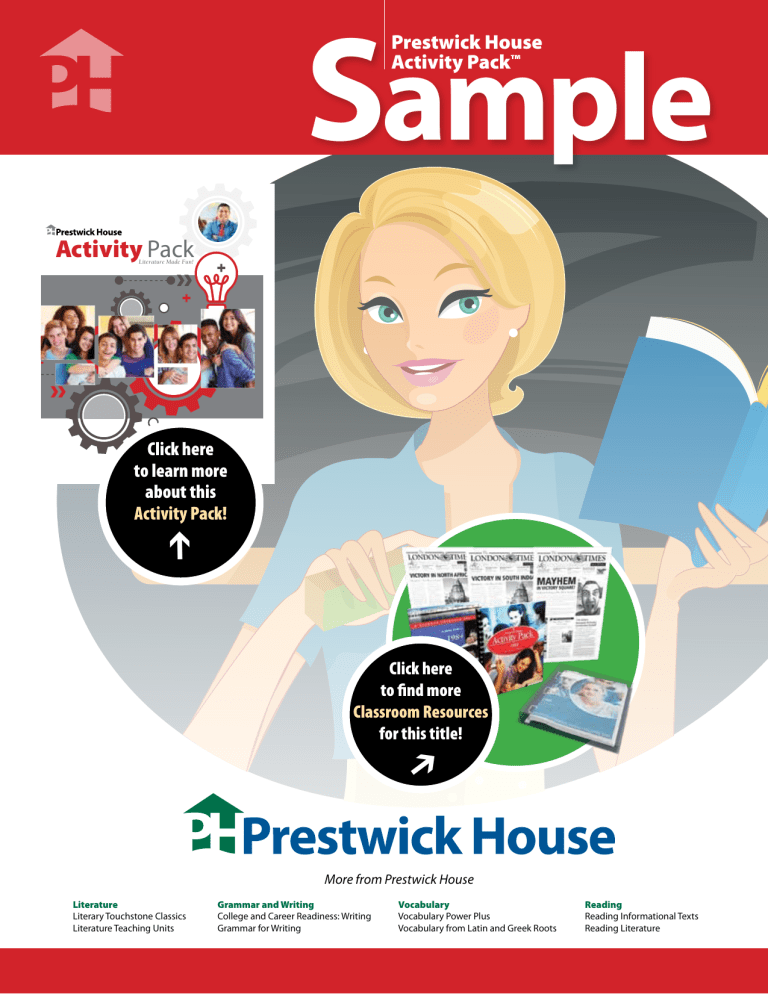
Sample Prestwick House Activity Pack™ Activity Pack Literature Made Fun! Lord of the Flies Click here to learn more about this Activity Pack! by W illiam G oldinG Click here to find more Classroom Resources for this title! More from Prestwick House Literature Literary Touchstone Classics Literature Teaching Units Grammar and Writing College and Career Readiness: Writing Grammar for Writing Vocabulary Vocabulary Power Plus Vocabulary from Latin and Greek Roots Reading Reading Informational Texts Reading Literature Activity Pack Literature Made Fun! Frankenstein by M ary S helley Copyright © 2002 by Prestwick House, Inc., P.O. Box 658, Clayton, DE 19938. 1-800-932-4593 • www.prestwickhouse.com Permission to copy this unit for classroom use is extended to purchaser for his or her personal use. This material, in whole or part, may not be copied for resale. ISBN 978-1-60389-231-5 Item No. 200943 Table of Contents Pre-Reading Author’s Purpose...........................................................................................................................4 Letters Character.......................................................................................................................................6 Setting............................................................................................................................................10 Characterization and Inference.....................................................................................................12 Characterization............................................................................................................................18 Theme............................................................................................................................................20 Romanticism..................................................................................................................................22 Imagery..........................................................................................................................................30 Chapters I – III Background....................................................................................................................................32 Characterization I..........................................................................................................................34 Characterization II........................................................................................................................38 Plot................................................................................................................................................44 Chapters IV – VI Reading for Details........................................................................................................................48 Interpreting the Text.....................................................................................................................50 Theme............................................................................................................................................56 Debate............................................................................................................................................58 Chapters VII – IX Debate............................................................................................................................................64 Using a Map..................................................................................................................................70 Point of View.................................................................................................................................74 Writing..........................................................................................................................................76 Chapter X Imagery..........................................................................................................................................78 Text Interpretation and Persuasive Argument..............................................................................80 Chapters XI – XVI Plot................................................................................................................................................86 Public Speaking.............................................................................................................................90 Writing..........................................................................................................................................92 Debate and Theme........................................................................................................................100 Chapter XVII Style...............................................................................................................................................106 © Copyright 2002, Prestwick House, Inc. 2 Chapters XVII – End Figurative Language......................................................................................................................114 Theme and Plot.............................................................................................................................118 Writing..........................................................................................................................................124 Summary Dramatization................................................................................................................................126 Wrap-Up Poetry Writing...............................................................................................................................128 Appendices Terms and Definitions...................................................................................................................130 Directions for a Debate..................................................................................................................134 Dramatization of Scenes in the Novel...........................................................................................135 Directions for Interviews...............................................................................................................136 Directions for a Dramatic Monologue...........................................................................................137 Newspaper.....................................................................................................................................138 Panel Discussion...........................................................................................................................140 Writing Poems...............................................................................................................................141 Small Group Learning...................................................................................................................143 Procedures for Small Group Work................................................................................................145 Small Group Evaluation Sheet......................................................................................................146 Student Roles in Group Discussions.............................................................................................147 All references come from the Prestwick House Literary Touchstone Classic Edition of Frankenstein, by Mary Shelley, published 2005. 3 © Copyright 2002, Prestwick House, Inc. Student’s Page­ Name: ________________________________ Frankenstein Date:_________________ Letters Character Objectives: Understanding character development Recognizing point of view Activity Consider all that R. Walton reveals about himself in his letters to create a profile of him. Use information from all of the letters. Each group should select a different aspect of Walton’s profile from the list that follows. Work in groups to fill out the form provided. Each group should present its profile once complete. Aspects of Walton’s Profile: • Walton’s Dream • Walton’s Past Failure as a Poet • Walton’s Willingness to Sacrifice • Walton’s Doubts • Walton’s Education • Walton’s Relationships with Others • Walton’s Financial Background • Walton’s Resolve or “Steady Purpose” S-7 Reproducible Student Worksheet Student’s Page­ Name: ________________________________ Frankenstein Date:_________________ Letters Imagery Objective: Visualizing the images and descriptive details of a literary work Activity Each group should select a different scene from the list that follows. Draw, use magazines, or find pictures on the Internet to create a visual representation of your group’s scene. Scenes: • Walton’s ship surrounded by ice and the sledge with “a being which had the shape of a man…of gigantic stature” in the distance • The sailors attempting to persuade a man who is on a fragment of ice in the sea to come on board the ship • The sailors attempting to restore the man who is in a “wretched” condition • The stranger’s interest in the demon seen earlier on the sledge • The stranger’s grief and love of the beauties of nature • The stranger’s reaction when Walton shares his dream • The stranger as he begins to share his “unparalleled misfortunes” with Walton S - 31 Reproducible Student Worksheet Student’s Page­ Name: ________________________________ Frankenstein Date:_________________ Chapters I – III Plot Objective: Understanding plot Activity When Victor turns seventeen, his life changes drastically. Referring to one day in this year, Victor says, “This ended a day memorable to me: it decided my future destiny.” List some of the important events that happen in Victor’s life during his first seventeen years. Beside each event, identify a reminder or token he probably has of the event. S - 45 Reproducible Student Worksheet Student’s Page­ Name: ________________________________ Frankenstein Date:_________________ Chapters IV – VI Debate Objectives: Responding to literature Relating literature to life Activity At the end of Chapter VI, Victor remarks: We returned to our college on a Sunday afternoon; the peasants were dancing, and every one we met appeared gay and happy. My own spirits were high, and I bounded along with feelings of unbridled joy and hilarity. In these chapters, Victor has created a life and abandoned it. He has no knowledge of what has become of his creation. Yet, he has gone on with his life and is able to feel joy again. Are you sympathetic to Victor? Should Victor have stayed in misery, or should he be able to put his mistake behind him and go on with his life? • Form two groups, one of people who sympathize and one of people who do not. • Debate the above questions. • Take notes about the arguments of both sides on the following handouts. Save these notes for Victor’s trial, which will occur after you have completed the novel. S - 59 Reproducible Student Worksheet Student’s Page­ Name: ________________________________ Frankenstein Date:_________________ MAP S - 73 Reproducible Student Worksheet Student’s Page­ Name: ________________________________ Frankenstein Date:_________________ Newspaper Assignments 1.Article on the creature’s appearance in the cottage: Base your article on an interview with DeLacey about what the creature says to him and an interview with Felix and Agatha about what they see and do. 2.Article on the creature’s appearance in the village: Base your article on interviews with people in the village. Include the woman and children who live in the house that the creature enters, the people who flee, and the people who attack the creature. 3.Human interest article on the misfortunes of the DeLacey family: Base your article on an interview with the elder DeLacey, Felix, Agatha, and Safie about their personal history. 4.Editorial on betrayal: Base your article on an interview with Felix about the betrayal by the Turk whom he helped. 5.Editorial on hope: Base your article on an interview with Safie about her situation, the reasons she has persevered, and how she is able to stay hopeful. 6.An Advice Column: The creature writes in about his situation. Include his letter. Write an answer detailing what you think he should do. 7.An Advice Column: Felix writes in about his fears for his father, wife, and sister. Include his letter and advise him. 8.An Advertisement: You are an inventor and have been following the news about the hideous creature. You devise a home protection system. Write an advertisement for your system. Tell people the reasons they need the system, and what it does. 9.Letter to the Editor: You have read the articles about the creature, betrayal, and hope. Write a Letter to the Editor explaining your feelings about the dangers that humans face. S - 95 Reproducible Student Worksheet Student’s Page­ Name: ________________________________ Frankenstein Date:_________________ Chapters XVII – End Figurative Language Objective: Understanding figurative language and how it creates meaning in literary text Activity One aspect of Mary Shelley’s style of writing is the use of figurative language. She uses the familiar to convey unfamiliar scenes and experiences. Mary Shelley uses many figurative devices in her writing: metaphor, simile, hyperbole, irony, paradox, etc. • Complete the following chart as you discuss the figurative language in your small groups. • In your group, find different instances in which Shelley uses figurative language. • Write the quote in the first column. • Use your notes on the chart to explain the use of figurative language in your group’s quotation to the rest of the class. • Explain the quote in the remaining column. S - 115 Reproducible Student Worksheet

